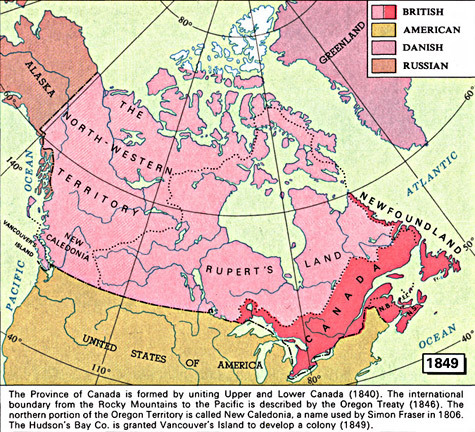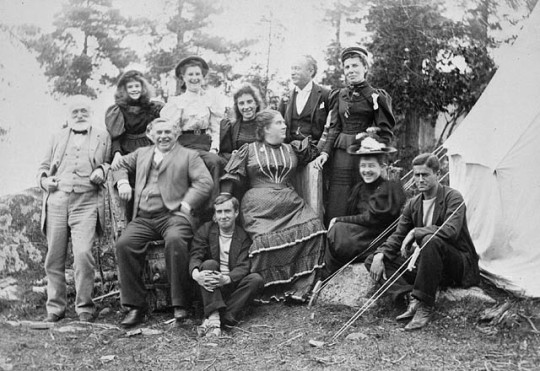Photo

1849 map showing the boundaries of the United Province of Canada, formed upon recommendation by Lord Durham, as well as indicating the state of the rest of what would become Canada at this time.
12 notes
·
View notes
Photo

Sir John A. Macdonald, standing in his office (Watercolour by Charles Jeffreys)
8 notes
·
View notes
Quote
Your existence as the first Representative Legislature of the United Colonies of British Columbia and Vancouver Island will be ephemeral. Another of the measures to which I have referred will be the cause of your own extinction and the substitution of a larger and differently constituted Legislative Body. But your Members may reflect with pride that to you has been confided the privilege of deciding upon the most important questions which have hitherto arisen, or are likely to arise for years to come, in the history of the Colony; to you belongs the honour of extending British American Confederation to the shores of the Pacific, and of cementing the foundations of a great and prosperous state, whose future promises to be enlightened and progressive.
Sir Anthony Musgrave, Governor of the United Colonies of Vancouver Island and British Columbia. On March 7th, 1871, Sir Musgrave closed what was to be the last session of this colonial legislature with this speech. When a legislative body next sat there, it would be as the Legislative Assembly for the Canadian Province of BC.
#Canada#Canadian history#British Columbia#Legislative Assembly#Vancouver Island#Colonial Canada#Sir Anthony Musgrave
5 notes
·
View notes
Photo

Campaign poster for the 1878 federal election. The National Policy was John A. Macdonad's platform of high tariffs, railroad construction, and increased western immigration which put back in power following the election of that year.
1 note
·
View note
Photo

Prime Minister J. J. Abbott's house on Sherbrooke Street, Montreal, photographed at the very end of the 19th century.
5 notes
·
View notes
Text
Who was...
Sir Charles Hibbert Tupper?
Charles Hibbert Tupper (1855-1927) was the son of Father of Confederation and Prime Minister Charles Tupper. Hibbert Tupper served in multiple Cabinets of the early Conservative prime ministers. He served as a Nova Scotian MP for 22 years, later moving to British Columbia where he would practice law for a number of years. For his part in the Bearing Sea Arbitration of 1893, Hibbert Tupper was rewarded with his knighthood by Her Majesty, Queen Victoria.
4 notes
·
View notes
Photo

Kim Campbell's official portrait. Painted by artist David Goatley in 2004, the portrait hangs as the sole female face in the Prime Minister's gallery in Parliament
#Kim Campbell#Prime MInister#Canada#Progressive Conservative#Haida#British Columbia#Canadian history
11 notes
·
View notes
Photo

John Diefenbaker flipping burgers at a party rally in Cloverdale, B.C. in 1967.
8 notes
·
View notes
Photo

Richard Bedford Bennett
0 notes
Text
Sir John A. Macdonald and the Bottle
Sir John A. has always been remembered, fondly or not, for his alcoholism. Despite this, Macdonald’s chronic dependence on the stuff was hardly a deterrent to the voters en mass, who themselves often likely heavy drinkers, save those who were wholly temperate. A common line of Sir John’s was that the people would prefer him drunk to his political foes sober.
One particular “incident” while Macdonald was highly intoxicated occurred while he was awaiting the arrival of the new governor general, the Marquess of Lorne. Upon their arrival from England, a messenger was sent to fetch the prime minister. The messenger burst into a room to find him lying inebriated on a bed. Macdonald’s response to the summons was to tipsily sit up, point one wrinkled finger at the caller and declare, “Vamoose from this ranch.”
11 notes
·
View notes
Text
Happy Birthday, Canada!
Canada Day, formerly called Dominion Day, marks the birthday of the Canadian confederation. On July 1st, 1867, the British colonies of Canada (split into the pseudo-colonies of Canada East and Canada West), Nova Scotia, and New Brunswick were “federally united into One Dominion under the Crown of the United Kingdom”. This new Dominion of Canada was by no means the nation we know today. Within a few years however, the government of Canada had purchased the vast expanses of territories known as Rupert’s Land and the North-Western Territory, more than doubling the country’s size. It wasn’t until 1949 though that Canada could boast of having ten provinces, and not until almost the turn of the century, three territories (Newfoundland joined in 1949; Nunavut was carved out of the Northwest Territories in 1999.)
In fact, the Dominion of Canada was not much more than a self-governing colony for much of its existence. “Canadian citizenship” didn’t exist until 1947 (Prime Minister W. L. Mackenzie King received the first citizenship certificate, numbered 0001, and announced to great applause, “I speak as a citizen of Canada.”) The maple leaf flag wasn’t adopted until 1965. And O Canada, now sung every Wednesday morning in the House of Commons, was not to become our national anthem until 1980. In 1867, the Fathers of Confederation were more interested in keeping the odd assortment of provinces safely out of reach from America’s manifest destiny than designing a nation.
A more appropriate “birthday” for Canada might instead be April 17th, the day it “patriated” its charter, formally breaking all non-ceremonial links with the United Kingdom. But both for tradition's sake, and because Quebec did not, in fact, agree to the patriation, July 1st is likely to remain our "sort-of-independence-day-but-not-really" holiday. The only effect that patriation on it was revamping the name. Canada had become a fully autonomous country, and as such began celebrating Canada Day rather than Dominion Day. (The idea of the name change floated around as far back as the 1950s and perhaps earlier, but was criticized but Prime Minister Diefenbaker because it suggested a loosening of ties to the mother country.)
This year, Canada celebrates 145 years since confederation. In that time it has seen twenty-two prime ministers carefully nurture the tiny sapling of a nation into a respectable player on the world stage. With a reputation for multiculturalism, a history of collectivism and an inherent penchant for rights and freedoms, it is a land like none other. Canada, quirks and all, has become a place that over 34 million people are proud to call home, and with all that has been accomplished in just 145 short years, an even brighter future lies inevitable ahead for the little country that could.
"Whatever you do, adhere to the Union. We are a great country, and shall become one of the greatest in the universe if we preserve it; we shall sink into insignificance and adversity if we suffer it to be broken."
- Sir John A. Macdonald, orchestrator of Confederation and first prime minister of Canada.
11 notes
·
View notes
Photo

Lester Pearson and President JFK in 196.
15 notes
·
View notes
Photo

Pierre Trudeau rides through the streets of Calgary at the 1978 Calgary Stampede.
25 notes
·
View notes
Photo

Prime Ministers Sir Mackenzie Bowell (far left) and John Thompson (sitting in the chair) with members of the Thompson family, as well as some unknown friends.
1 note
·
View note
Photo

Newfoundland Premier and "Last Father of Confederation" Joey Smallwood with John Diefenbaker. The two shared the kind of particularly unpleasant relationship that you would expect between a liberal and a conservative, though Joey had always admired Diefenbaker's skill in the House of Commons.
#John Diefenbaker#Joey Smallwood#Canada#Canadian History#Liberal#Progressive-Conservative#Newfoundland#prime minister
12 notes
·
View notes
Text
Arthur Meighen and Joe Clark
Arthur Meighen and Joe Clark are perhaps the only two whose post-prime ministerial careers were more illustrious and successful than when they were in power. Both leaders of Canada’s historical conservative party (the “National Liberal and Conservative” party under Meighen and the “Progressive-Conservative” party under Clark), they served less than three years in the PMO between the two of them.
Following Meighen’s fall from power, R.B. Bennett would eventually appoint him to the senate, where he would serve Bennett as a Minister without Portfolio and Government Leader in the Senate. He would later resign his seat and again take up the mantle of Conservative leader for a year during the Second World War. Upon a proper leadership convention, Meighen finally passed leadership onto John Bracken, before retiring into his Toronto law practice.
Joe Clark didn’t have a senate appointment coming his way, but he would make his way onto Brian Mulroney’s cabinet as and incredibly adept Secretary of State for External Affairs, a position he filled with much greater esteem than his nine-month stint as prime minster. As well, Clark would go on to take over the position of Minister of Constitutional Affairs and, a few years later, regain leadership of the party. Clark would eventually retire from leadership and the party, and take up teaching as university professor, which he still continues to do to this day.
Meighen and Clark also share one more thing in common: they hold the records for the longest and second-longest retirement of a Canadian Prime Minister.
Joe Clark
Arthur Meighen
1 note
·
View note
Photo

Robert Borden on the green.
3 notes
·
View notes